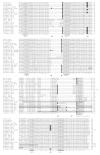Rapid functional diversification in the structurally conserved ELAV family of neuronal RNA binding proteins
- PMID: 18715504
- PMCID: PMC2529313
- DOI: 10.1186/1471-2164-9-392
Rapid functional diversification in the structurally conserved ELAV family of neuronal RNA binding proteins
Abstract
Background: The Drosophila gene embryonic lethal abnormal visual system (elav) is the prototype of a gene family present in all metazoans. Its members encode structurally conserved neuronal proteins with three RNA Recognition Motifs (RRM) but they paradoxically act at diverse levels of post-transcriptional regulation. In an attempt to understand the history of this family, we searched for orthologs in eleven completely sequenced genomes, including those of humans, D. melanogaster and C. elegans, for which cDNAs are available.
Results: We analyzed 23 orthologs/paralogs of elav, and found evidence of gain/loss of gene copy number. For one set of genes, including elav itself, the coding sequences are free of introns and their products most resemble ELAV. The remaining genes show remarkable conservation of their exon organization, and their products most resemble FNE and RBP9, proteins encoded by the two elav paralogs of Drosophila. Remarkably, three of the conserved exon junctions are both close to structural elements, involved respectively in protein-RNA interactions and in the regulation of sub-cellular localization, and in the vicinity of diverse sequence variations.
Conclusion: The data indicate that the essential elav gene of Drosophila is newly emerged, restricted to dipterans and of retrotransposed origin. We propose that the conserved exon junctions constitute potential sites for sequence/function modifications, and that RRM binding proteins, whose function relies upon plastic RNA-protein interactions, may have played an important role in brain evolution.
Figures





References
Publication types
MeSH terms
Substances
LinkOut - more resources
Full Text Sources
Molecular Biology Databases

